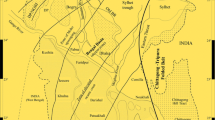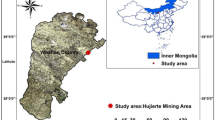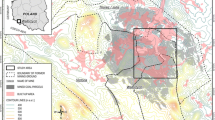Abstract
Total thickness of strata and coal cycle parameters of the three formations, i.e. Karharbari, Barakar, and Barren Measures of the Damuda Group of the Talchir Gondwana basin were subjected to bivariate and multivariate statistical analyses. Polynomial regression lines were fitted to data sets consisting of total thickness of strata, number of coal cycles, and average thickness of coal cycles of the three formations of the Damuda Group. A significant direct relationship is observed between total thickness (net subsidence) of strata and number of coal cycles, while a significant inverse relationship exists between the number of coal cycles and their average thickness. Principal component and multiple regression analyses suggest that lithological parameters of the coal bearing strata reflect the dynamic of the basin subsidence. The sedimentary distributive mechanism in the form of lateral migration of streams or drainage diversion caused in response to differential subsidence of the depositional surface seem to be appropriate mechanisms for the development of coal cycles and peat swamps in the Talchir basin. Often during Karharbari sedimentation, peat accumulated in abandoned channels was scoured away by high energy migrating channels. On the other hand, Barakar peat swamps developed in a distal part of the flood plain, as a result of which many of the coal seams could be of appreciable thickness. The advent of arid climatic condition retarded the growth of vegetation to a larger extent that prevented profuse development of coal seams during the Barren Measures Formation.
Similar content being viewed by others
References
Allen JRL (1965) Fining upward cycles in alluvial successions. Geol J 4:229–246
Belt ES, Sakimoto SEH, Rockwell BW (1992) A drainage diversion hypothesis for the origin of widespread coal beds in the Williston basin: Examples from Palaeocene strata, eastern Montana. In: Sholes MA (ed) Coal geology of Montana. Mon Bur of Mines and Geology Spec Publ, vol 102, pp 21–60
Casshyap SM (1970) Sedimentary cycles and environment of deposition of the Barakar coal measures of Lower Gondwana, India. J Sed Petrol 40:1302–1317
Casshyap SM (1975) Cyclic characteristics of coal-bearing sediments in the Bochumer Formation (westphal A 2) Ruhrgebiet, Germany. Sedimentology 22:237–255
Das R, Pandya KL (1995) Lithofacies and environment of deposition of a part of Damuda Group, Talchir basin, Orissa. In: Vistas in geological research, special publication in geology, vol 1. Utkal University, Bhubaneswar, pp 152–159
Davis JC (2002) Statistics and data analysis in geology. Wiley, New York
Duff PMcL (1967) Cyclic sedimentation in the Permian coal measures of New South Wales. J Geol Soc Aust 14:293–307
Duff PMcL, Hallam D, Walton EK (1967) Cyclic sedimentation. Development in sedimentology, vol 10. Elsevier, Amsterdam
Hota RN (2005) Geometry and compositional variation of coal seam IV of Talchir coalfield, Orissa—a clue to coal development. In: Vistas in geological research, special publication in geology, vol 4. Utkal University, Bhubaneswar, pp 155–167
Hota RN (2006) Geometry and compositional variation of coal seam V of the Barakar Formation of Talchir coalfield, Orissa—an aid to coal development. In: Vistas in geological research, special publication in geology, vol 5. Utkal University, Bhubaneswar, pp 102–109
Hota RN (2007) Geometry and compositional variation of coal seam VI of the Barakar Formation of Talchir Gondwana basin, Orissa. In: Vistas in geological research, special publication in geology, vol 6. Utkal University, Bhubaneswar, pp 21–27
Hota RN, Maejima W (2004) Comparative study of cyclicity of lithofacies in Lower Gondwana formations of Talchir basin, Orissa, India: A statistical analysis of subsurface logs. Gond Res 7:353–362
Hota RN, Pandya KL (2002) Quantitative relationship between net subsidence and coal cycles in Barakar Formation, Talchir coal field, Orissa. J Geol Soc India 60:203–211
Hota RN, Pandya KL, Maejima W (2003) Cyclic sedimentation and facies organization of coal bearing Barakar Formation, Talchir Gondwana basin, Orissa, India: a statistical analysis of subsurface logs. J Geosci, Osaka City University, Japan 46:1–11
Hota RN, Maejima W, Mishra B (2007) River metamorphosis during Damuda sedimentation: a case study from Talchir Gondwana basin, Orissa. J Geol Soc India 69:1351–1360
Johnson KR, Cook AC (1973) Cyclic characteristics of sediments in the Moon Island Beach Subgroup, New Castle coal measures, New South Wales. Math Geol 5:91–110
Khan ZA, Tewari RC (1991) Net subsidence and number of coal cycles; their interrelationship in different Permian Gondwana basins of peninsular India. Sediment Geol 73:161–169
Pandya KL (2006) Gondwanas. In: Mahalik NK, Sahoo HK, Hota RN, Mishra BP, Nanda JK, Panigrahi AB (eds) Geology and mineral resources of Orissa. Society of Seoscientists and Allied Technologists, Bhubaneswar, pp 91–103
Raja Rao CS (1982) Coal resources of Tamilnadu, Andhra Pradesh, Orissa and Maharastra. Bull Geol Surv India 45(II):41–52
Read WA, Dean JM (1967) A quantitative study of a sequence of coal bearing cycles in the Namurian of Central Scotland. Sedimentology 9:137–156
Read WA, Dean JM (1972) Principal component analysis of lithologic variables from some Namurian (E2) paralic sediments in Central Scotland. Bull Geol Surv G B 40:83–99
Read WA, Dean JM (1976) Cycles of subsidence: their relationship in different sedimentary and tectonic environments in the Scottish Carboriferous. Sedimentology 23:107–120
Read WA, Dean JM (1982) Quantitative relationships between numbers of fluvial cycles, bulk lithological composition and net subsidence in a Scottish Namurian basin. Sedimentology 29:181–200
Tewari RC (2008) Net subsidence and evolution of coal swamps in Early Permian coal measures of eastern India Gondwana basins using principal component analysis. J Geosci, Osaka City University, Japan 51:27–34
Author information
Authors and Affiliations
Corresponding author
Rights and permissions
About this article
Cite this article
Hota, R.N. Relationship between Net Subsidence and Coal Cycle Parameters—A Statistical Appraisal from Subsurface Logs of Damuda Group, Talchir Gondwana Basin, India. Math Geosci 42, 223–242 (2010). https://doi.org/10.1007/s11004-009-9243-3
Received:
Accepted:
Published:
Issue Date:
DOI: https://doi.org/10.1007/s11004-009-9243-3




